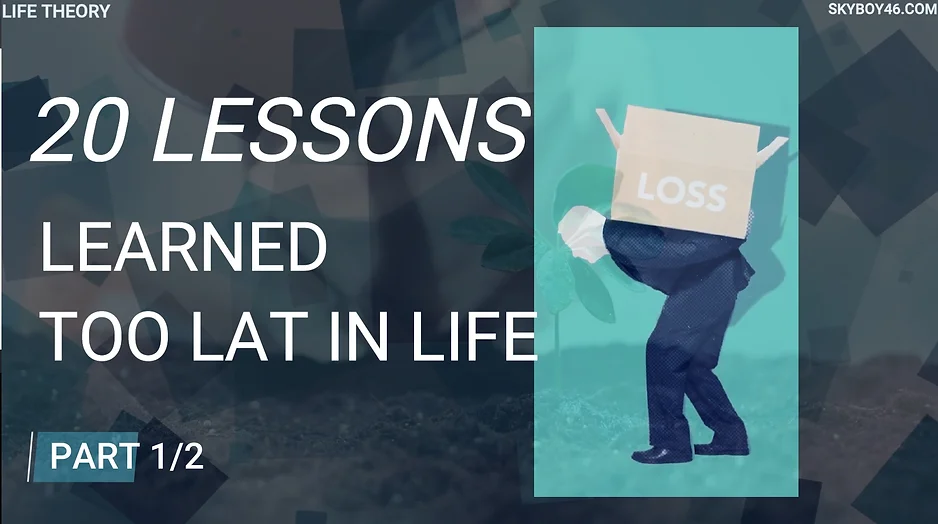15 Practices of Money-Smart People
Money-Smart
From understanding the allure of luxury and its pitfalls to debunking the illusion of bought friendships, we’ll explore a range of habits and mindsets that separate the financially savvy from the rest. Each topic will not only provide insights but will also equip you with actionable strategies to make more informed financial decisions.
15 Practices of Money-Smart People
“Welcome to another episode on Life Theory! If you’ve ever wondered why some people seem to have a natural knack for managing their finances while others are always caught in the cycle of debt and struggle, this is the episode for you. Today, we’re going to unlock the ’15 Practices of Money-Smart People.’
From understanding the allure of luxury and its pitfalls to debunking the illusion of bought friendships, we’ll explore a range of habits and mindsets that separate the financially savvy from the rest. Each topic will not only provide insights but will also equip you with actionable strategies to make more informed financial decisions.
But we warn you, some of these truths might challenge your current beliefs. But remember, transformation begins outside your comfort zone. So, buckle up and get ready for a journey that has the potential to change the way you think about and handle your money. Let’s get started!”
Number 1. Splurging on Luxury for Luxury’s Sake.
Let’s start with one critical habit – avoiding splurging on luxury for luxury’s sake. In a world defined by status symbols and flashy displays of wealth, it’s easy to get drawn into the allure of luxury items. Designer labels, high-end cars, and palatial homes can be tempting purchases when you’ve got money to spend. But is it wise to splurge on luxury just because you can?
Money-smart people say no. They recognize that true wealth isn’t about outward displays of prosperity. It’s about financial stability, freedom, and the ability to live life on their terms. This doesn’t mean they avoid luxury altogether. Instead, they purchase luxury items with discernment, choosing those that offer genuine value, serve a purpose, or bring them genuine joy.
They understand that every dollar spent on a luxury item is a dollar not spent on an investment, a meaningful experience, or a contribution to their long-term financial goals. Therefore, they weigh each luxury purchase against its opportunity cost.
Furthermore, money-smart people know that many luxury items depreciate rapidly, quickly losing their value after purchase. They prefer to invest in assets that appreciate over time, contributing to their wealth rather than draining it.
How does one navigate the world of luxury? The key lies in understanding the difference between want and need, and in being able to separate emotional impulses from rational decision-making. When the focus shifts from impressing others to building true, lasting wealth, luxury purchases become less about status and more about personal satisfaction and value.
As we delve deeper into the world of smart money management, keep this first lesson in mind. True wealth isn’t about what you show to the world; it’s about what you’re building behind the scenes. So, avoid splurging on luxury for luxury’s sake and make thoughtful, purposeful decisions about how to use your money.
Number 2. Competing with the Neighbors’ Wealth.
This isn’t just about literal neighbors, but also friends, colleagues, and even celebrities we follow on social media.
A fancy car pulls up in the driveway next door or a friend shares pictures of their exotic vacation on social media. These are all scenarios where you might feel a tinge of envy and a desire to keep pace. This temptation to match or outdo the spending of those around us is an emotional quagmire that money-smart people steer clear from.
Money-savvy individuals understand that wealth is not about comparison but about reaching one’s financial goals and achieving financial freedom. They resist the urge to match or exceed the spending of those around them, choosing instead to focus on their own financial health and long-term stability. It’s about running your own race, not getting swept up in the illusion of others’ wealth.
They recognize that outward displays of wealth may not reflect the true financial picture. The flashy car or the extravagant vacation could be the result of debt or poor money management. Conversely, a modest lifestyle could be masking a substantial net worth. The truth is, wealth is often invisible, and trying to keep pace with an illusion is an exercise in futility.
By steering clear of wealth competition, money-smart individuals maintain control over their financial destinies. They make decisions based on their financial realities and goals, not on external pressures.
Number 3. Purchasing Diamonds as a Status Symbol.
Ah, diamonds. These dazzling gemstones have long been associated with wealth, power, and romance. But money-smart people know there’s more to the story. Buying a diamond isn’t necessarily a bad move, but buying one merely as a status symbol, now that’s a different game.
Diamonds, while beautiful, are not the rare commodities we’ve been led to believe. The scarcity of diamonds is largely a construct of the market, controlled by a small number of companies who regulate supply to maintain high prices. Additionally, the value of a diamond doesn’t appreciate over time, making it a poor investment if one’s goal is wealth accumulation.
Intelligent spenders understand that the real value of a diamond, like many luxury items, lies more in its emotional or sentimental worth than its financial value. A diamond ring might symbolize a precious relationship or a significant milestone, and there’s undeniable value in that. But as a symbol of wealth or a status booster, a diamond is much less effective than sound investments or tangible assets.
When it comes to demonstrating wealth or success, money-smart people opt for investments that grow in value over time or contribute to their long-term financial security. They understand that a diamond’s sparkle may impress at a dinner party, but it’s their financial health that truly shines in the long run.
Our next topic takes us into the realm of property acquisition, a significant milestone for many but also a potential pitfall if not approached correctly. Stay tuned, we’re about to debunk the myth of love at first sight when it comes to buying a house.
Number 4. Choosing Less Cost-Effective Alternatives.
For some, spending more on a product or service may seem like the path to superior quality. After all, isn’t it common belief that you get what you pay for? Yet, money-smart individuals understand that this isn’t always the case. Higher price doesn’t automatically equate to higher value.
These individuals are adept at discerning the difference between cost and value. They understand that often, brand names and clever marketing can inflate the price of a product without necessarily enhancing its quality or functionality. They’re not lured by the perceived prestige that accompanies high-end brands if a more cost-effective alternative delivers the same results.
Consider, for example, generic pharmaceuticals versus brand-name drugs. The active ingredients are the same, but the price difference can be substantial. Or think about clothing. Designer labels might carry a high price tag, but often, similar styles can be found at more budget-friendly retailers.
By choosing less cost-effective alternatives, people often end up paying more for the brand name or the image associated with a product, rather than its actual performance. Savvy spenders, however, prioritize value over price. They’re more interested in the benefit they derive from a product or service, rather than the prestige attached to it.
It’s important to remember that being money-smart doesn’t mean being cheap. It’s about making informed decisions, understanding the value you’re getting for your money, and ensuring that your spending aligns with your financial goals.
Number 5. Impulsive Buying: The First House Love Affair.
Ah, the lure of the first house. It’s a milestone, a sign of adulthood, of financial stability, a symbol of personal success. Yet, as tempting as it is to sign on the dotted line for the first house that sparks a love affair in your heart, money-smart individuals know better. Let’s talk about the pitfall of impulsive buying when it comes to property.
Falling in love at first sight isn’t just for romantic movies; it happens in the realm of real estate too. The moment you walk into a house and it feels like home, you might feel compelled to make it yours. Yet, this emotional attachment can cloud judgment and lead to costly mistakes.
Purchasing a house is one of the most significant financial commitments you’ll likely make in your lifetime. Therefore, it requires careful thought, thorough research, and the patience to wait for the right fit. Smart buyers know this and don’t rush into making a purchase.
They inspect multiple properties, comparing their price, location, amenities, and potential for appreciation. They check for any hidden issues, such as plumbing or electrical problems, that could lead to unexpected expenses down the line. They assess whether the house aligns with their long-term life plans, like their career or family goals.
Moreover, money-smart people understand the importance of negotiation in the home buying process. If you’re too eager to buy, you may lose the opportunity to negotiate a lower price, favorable closing costs, or necessary repairs.
Falling in love with the first house you see is easy. However, resisting the urge to buy impulsively and doing the due diligence before making a decision is what sets money-smart individuals apart.
Number 6. Investing in Hype Rather than Substance.
In a world dominated by social media and constant information flow, getting caught up in the hype is a common pitfall. Be it the latest tech startup, a hot cryptocurrency, or a trending stock, the noise can often blur the lines between substance and spectacle. However, people who have honed their money-smart skills know the difference and navigate these waters with discernment.
Let’s clear this up: Investing in hype is akin to betting on the grandeur of a firework display instead of the science that launches it. It’s alluring, mesmerizing, but ultimately ephemeral. On the other hand, investing in substance is like backing the team of engineers who calculate trajectories, test materials, and ensure a successful launch every single time.
Hype is fueled by emotion, speculation, and the fear of missing out, all of which are volatile and unsustainable in the long term. Substance, however, is grounded in solid research, analysis, and the long-term value of a product or service.
For example, think about the dotcom bubble of the late 90s or the more recent crypto crazes. Many people, swayed by the hype, invested huge sums into these trendy assets, only to suffer when the bubble burst. In contrast, those who studied the market, understood the technology, and its potential were able to make informed decisions, either avoiding unnecessary losses or even profiting from these volatile situations.
To invest in substance over hype, one needs to cultivate financial literacy, understand the fundamentals of investing, and develop the patience to see beyond immediate gratification. It’s about asking the right questions: Does this company have a sound business model? Is this asset truly valuable or just artificially inflated? What’s the risk and potential return?
Number 7. The Fallacy of State-Sponsored Retirement Belief.
The belief in a state-sponsored retirement is a comforting thought for many. The notion that after years of hard work and dutiful contributions to society, a comfortable retirement awaits. However, for those who are truly money-smart, this belief is more of a fallacy than a concrete financial plan.
Consider the vast array of economic variables at play. Inflation, changes in government policy, fluctuations in the job market, and many more factors can significantly impact the viability of state-sponsored retirement schemes. Furthermore, depending on where you live, the sheer number of retirees compared to the working population may strain these systems to a breaking point.
People who are savvy about their finances understand these risks and take proactive steps to secure their futures independently. They recognize the need for personal savings, diversified investments, and other sources of passive income that can provide financial stability in their golden years.
Does this mean state-sponsored retirement schemes are entirely useless? Not at all. They can form a part of a broader, more comprehensive retirement plan. But relying solely on them is akin to placing all your eggs in one basket, and that’s something money-smart individuals are wary of.
Furthermore, planning for retirement is not just about having enough money to live on. It’s also about having the financial freedom to enjoy life, travel, pursue hobbies, and spend time with loved ones without worrying about every penny. A state-sponsored retirement scheme rarely provides this level of financial comfort.
So, the real secret to a secure retirement lies in starting early, investing wisely, and always having a diversified approach to wealth creation. This principle will serve you well not just in retirement planning, but in all aspects of your financial journey.
Number 8. Sacrificing Energy Efficiency.
In the realm of financial prudence, there’s a somewhat hidden factor that is often overlooked, yet it has a profound impact on long-term financial health. This factor is energy efficiency. Money-smart individuals know that being wasteful when it comes to energy is akin to draining financial resources over time.
Think about it. Every light left on unnecessarily, every degree higher on the thermostat during winter or lower during summer, every appliance running when it doesn’t need to be, they all add up to a substantial amount over time. And while the cost might seem insignificant on a day-to-day basis, the cumulative effect over years can be startling.
But energy efficiency is not just about switching off lights. It’s about making smart choices when buying appliances, choosing energy-efficient models even if they cost a little more upfront. It’s about proper insulation in homes to reduce heating and cooling costs. It’s about opting for renewable energy sources if possible, like solar panels, which can significantly reduce electricity bills in the long run.
The principle of energy efficiency extends beyond just home and appliances. It’s also about making energy-smart choices in transportation, like choosing fuel-efficient cars or using public transport, cycling, or walking when feasible.
In essence, being energy efficient is about respecting resources and understanding that unnecessary wastage is a direct drain on financial resources. It reflects a mindset of conservation and responsibility, qualities that go hand in hand with financial prudence.
Number 9. Mistakes: The Unintended Financial Leaks.
A defining trait among the money-smart is their approach to mistakes. Rather than shrugging them off or hiding from them, they treat mistakes as learning opportunities, especially when these blunders result in financial leaks. Let’s explore this a bit more.
Everyone makes mistakes, whether it’s forgetting to cancel a subscription, making a poor investment, or buying something on a whim only to realize later that it was unnecessary. While these may seem like minor missteps, the accumulation of these small errors can lead to substantial financial leaks over time. And money-smart individuals are keenly aware of this.
In the financial world, the cost of mistakes isn’t just about the immediate financial loss. It’s also about the opportunity cost. Every dollar spent unnecessarily is a dollar that could have been invested or saved, growing over time. Therefore, the true cost of a mistake is often far greater than what appears on the surface.
But here’s where the money-smart distinguish themselves. Instead of repeating their mistakes, they study them. They analyze what went wrong and why. They look for patterns in their behavior that may have led to the mistake. And most importantly, they seek to learn from the experience, implementing changes to avoid repeating the mistake in the future.
This learning-oriented approach turns mistakes from mere financial leaks into valuable lessons. It transforms a negative experience into a positive force for change and growth. And in the long run, this mindset contributes significantly to financial success.
Number 10. The Illusion of Friendship Bought with Money.
The idea of buying friendship is enticing, isn’t it? With wealth, one can afford lavish gifts, extravagant parties, or generous favors, all of which seem like surefire ways to attract people and, by extension, friendships. However, the money-smart understand that these relationships, founded on the transactional nature of financial generosity, often lack depth and sincerity.
Think of it this way: a friendship built on the foundation of money is like a house built on sand. It may appear sturdy when the weather is calm, but as soon as the storms hit – in this case, when the money runs out – the foundation crumbles, and the house collapses. Money can attract people, but it can’t guarantee their loyalty, their sincerity, or their genuine affection.
Moreover, attempting to buy friendship often leads to a skewed power dynamic that can foster resentment and conflict. It can create a sense of obligation and indebtedness that robs the relationship of its authenticity.
The financially wise focus on building relationships based on shared values, mutual respect, and genuine affection. They understand that the most rewarding friendships are those where money is a non-factor, where people are valued for who they are, not for what they can offer. These are the relationships that stand the test of time, that provide emotional richness, and that contribute to a fulfilling and balanced life.
Number 11. Shelling Out Full Price Without Negotiation.
You see, those who are savvy with their finances understand one key principle: rarely should you pay full price without attempting to negotiate. Let’s explore why this is and how it plays a crucial role in maintaining financial health.
Negotiation is a powerful tool in the financial toolkit of the wise. It’s not merely about haggling over a price tag; it’s about recognizing the inherent flexibility in most financial transactions and leveraging that to your advantage. The act of negotiation demonstrates an understanding that the price asked is not always the price required.
Let’s take a simple example: purchasing a car. The sticker price is rarely the final price, and savvy buyers know this. They’ll research, compare prices, and negotiate based on this knowledge. They understand that saving money isn’t only about what you do with your money after it’s in your account; it’s also about being proactive in reducing your expenses in the first place.
But the realm of negotiation extends beyond tangible goods. It applies to services too, from your internet provider to your insurance premiums. There’s often room to negotiate better terms or rates, but this room only opens up when you ask for it.
However, negotiation is an art. It requires patience, tact, and the ability to communicate effectively. It’s not about demanding lower prices; it’s about discussing and arriving at a mutually beneficial arrangement.
The takeaway here is simple: don’t be afraid to negotiate. Question the price tags, the rates, and the terms you’re offered. Sometimes, you’ll be met with a firm no, but often you’ll find there’s wiggle room. And that room is where money-smart people find their savings.
Number 12. Unnecessary Upgrades: The ‘Just Because’ Syndrome.
This is a common pitfall where individuals upgrade items, not out of necessity, but because they can, often leading to financial drain.
Imagine this. You have a smartphone that’s in perfect working condition, fulfilling all your needs. Then a new model launches. It’s shiny, it’s new, and it has a few extra features that seem cool but aren’t necessarily essential. You’re tempted to upgrade, just because you can. This, dear Life Theory listeners, is the ‘just because’ syndrome.
The financially smart approach is to resist this impulse. It’s important to differentiate between needs and wants. While it’s perfectly fine to want the latest tech or the trendiest fashion, these desires should be indulged in a financially responsible manner. If an upgrade doesn’t significantly enhance your quality of life or work, it might not be a financially wise move.
Think of your possessions as investments. Each item you own should add value to your life, either by serving a purpose or by bringing you joy. Upgrading for the sake of owning the latest version often leads to a cycle of endless spending, as there’s always something newer and better around the corner.
Remember, money-smart individuals aren’t those who can afford to buy everything they want, but those who know when not to spend even when they can afford it. They understand that financial freedom doesn’t come from owning the latest gadgets, but from being in control of your spending and making choices that align with your financial goals.
Number 13. Rent vs. Buy: The Eternal Debate.
On one hand, owning a property is often seen as a symbol of stability and success. It’s a tangible asset, something you can touch and feel, which carries with it a sense of achievement. However, with ownership comes the responsibility of maintenance, taxes, and the potential risk of property value depreciation.
On the other hand, renting offers flexibility. If you’re someone who values freedom, mobility, or if you’re in a stage of life where you’re not ready to commit to a particular location, renting can be the ideal option. It absolves you from the hassles of property upkeep and offers the liberty to move whenever you want or need to. Plus, the money saved on a down payment can be invested elsewhere for potential returns.
But, renting also comes with its downsides. You’re not building equity, you’re subject to the whims of a landlord, and there’s a sense of impermanence that can be unsettling for some.
So, what’s the money-smart approach? Well, it depends on personal circumstances. There’s no one-size-fits-all answer. The financially savvy know that both renting and buying have their place, and the right choice varies depending on individual lifestyle choices, financial status, and long-term goals.
They analyze the cost-benefit ratio of both options and choose what makes the most sense for them at a particular stage in life. Most importantly, they don’t let societal pressure dictate their decision. They understand that owning a home isn’t the only path to financial success, and sometimes, the flexibility and financial liquidity offered by renting can be just as valuable.
Number 14. The Allure of Add-Ons and Their Hidden Costs.
Ah, the lure of the add-ons. You’re making a purchase, and right when you’re about to check out, you’re enticed with additional features, upgrades, or related items that seem too good to pass up. It might be an extended warranty on a new appliance, a premium subscription for an app you’re just trying out, or the tempting extras thrown in while buying a new car. They seem small, almost insignificant in the grand scheme of your purchase. However, they often come with hidden costs that can pile up without you realizing it.
This is a tactic widely used by businesses to increase their profits. It’s not necessarily a bad thing – after all, these add-ons often provide added value or convenience. But the problem arises when we fall into the trap of mindlessly accepting these add-ons without considering if we truly need them, or if they’re worth the extra cost.
The money-smart individuals have a knack for navigating this tricky territory. They understand that while some add-ons can offer value, others are unnecessary expenses that can be avoided. They carefully evaluate the benefits of these extras against their cost, their budget, and their actual needs.
They also recognize that the costs of these add-ons can accumulate over time, quietly draining their resources. That extra warranty may seem cheap now, but if you add it to every appliance you buy, you might end up spending a small fortune on warranties that you never end up using.
So, the next time you’re tempted by an add-on, pause and consider: Is this something you really need? Will it add value to your life or your purchase, or is it just an impulse buy? Remember, every penny saved is a penny earned, and often, financial success is built not by making big financial decisions right, but by making the small ones right, consistently.
Number 15. Confusing Love with Financial Leverage.
When it comes to finances, one of the most emotionally complicated subjects is the intersection of love and money. It’s not uncommon to fall into the trap of leveraging affection, a practice that has more to do with seeking validation and maintaining power dynamics than genuine love or concern. The belief that you can buy affection or demonstrate your love through financial gestures is not only flawed but can also lead to unhealthy relationships and financial strains.
Many tend to equate spending with caring, believing that the more they spend on their loved ones, the more they demonstrate their love. Whether it’s buying extravagant gifts to impress a partner or going into debt to provide a lavish lifestyle for one’s family, using money as a measure of affection often causes more harm than good.
On the surface, these actions might seem like expressions of love, but in reality, they often stem from a desire to control or a fear of rejection. The perceived need to maintain a certain image or lifestyle can lead to financial decisions that are unsustainable in the long run. Moreover, these gestures might create an unhealthy dependency or set unrealistic expectations that could strain the relationship.
The money-smart understand that real affection isn’t about the price tag on the gifts they give or the luxury of the experiences they provide. It’s about being present, authentic, and supportive in ways that matter. They know that while money can buy comfort and convenience, it cannot buy genuine affection or respect.
It’s essential to separate emotional well-being from financial behaviors and to build relationships on mutual respect, trust, and affection, rather than on material possessions or financial gestures.
And with that, we come to the end of this enlightening journey through the practices of money-smart people. Remember, the road to financial wellness is paved with informed decisions, sensible habits, and an understanding of the value, not just the price.
It’s not just about how much you earn, but how you manage, save, and invest your money that determines your financial future. As we’ve learned, being money-smart involves thoughtful decisions, disciplined habits, and a clear understanding of the value of money.
We hope you’ve gained valuable insights that you can apply to your own financial journey. It’s never too early or too late to start making smarter financial decisions.
Thank you for spending your time with us. Remember, the more you learn, the more you earn! Until next time, keep on rising!”
–> Read More Life Stories Here:
https://www.lifetheory.eu
https://www.lifetheory.us
SHARE THIS STORY
Visit Our Store
SHOP NOW
www.skyboy46.com & www.myskypet.com
Designed For Pet Lovers & Introverted Souls
Sport, Hobbies, Motivation, Music & Art






EXPLORE MORE:
www.linktr.ee/skyboy46



